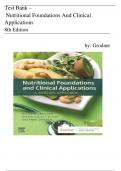Test Bank –
Nutritional Foundations And Clinical
Applications
8th Edition
by: Grodner
, Table Of Contents
PART I: Wellness, Nutrition, And The Nursing Role
1. Wellness Nutrition
2. Personal And Community Nutrition
PART II: Nutrients, Food, And Health
3. Digestion, Absorption, And Metabolism
4. Carbohydrates
5. Fats
6. Protein
7. Vitamins
8. Water And Minerals
PART III: Health Promotion Through Nutrition And Nursing Practice
9. Energy, Weight And Fitness
10. Nutrition Across The Life Span
PART IV: Overview Of Medical Nutrition Therapy
11. Nutrition Assessment And Patient Care
12. Food-Related Issues
13. Nutrition For Disorders Of The Gastrointestinal Tract
14. Nutrition For Disorders Of The Liver, Gallbladder, And Pancreas
15. Nutrition For Diabetes Mellitus
16. Nutrition In Metabolic Stress: Burns, Trauma, And Surgery
17. Nutrition For Cardiopulmonary Disease
18. Nutrition For Diseases Of The Kidneys
19. Nutrition For Neuro-Psychiatric Disorders
20. Nutrition In Cancer And HIV-AIDS
,Chapter 01: Wellness Nutrition
Grodner Et Al.: Nutritional Foundations And Clinical Applications: A Nursing Approach, 8th Edition
MULTIPLE CHOICE
1. Examples Of Informal Education Include
a. Attending A Workshop On Coronary Artery Disease Sponsored By The American
Heart Association.
b. Watching A Television Show About Diabetes.
c. Learning About Food Safety Techniques In A High School Economics Course.
d. Joining A Support Group To Help Overcome An Eating Disorder.
CORRECT ANSWER: B
Watching A Television Show About Diabetes Is An Example Of Informal Education Because
It Is An Experience That Occurs Through A Daily Activity. Attending A Workshop Or
Joining A Support Group Would Be Considered Nonformal Education; A High School
Course Would Be Considered Formal Education.
DIF: Cognitive Level: Applying REF: Page 13
TOP: Nursing Process: Implementation MSC: Client Needs: Health Promotion And Maintenance
2. A College Student Exercises Regularly And Generally Eats A Healthy Variety Of Foods, Is
Taking A Course In General Nutrition, Buys Locally Produced Food Whenever Possible, Is
An Active Member Of An On-Campus Faith-Based Organization, And Keeps A Journal To
Help Process Her Emotions. What Else Could B eni mr
p o rtian t gf o r b
h e.R c
t o Inmclude In Her
Life In Order To Develop Her Overall Wellness?
a. Growing Some Of Her Own Food
, b. Keeping A Food Record To Help Evaluate What She Eats
c. Eating Meals With Friends Throughout The Week
d. Meeting With A Registered Dietitian To Review Her Food Choices
CORRECT ANSWER: C
Wellness Enhances A Person’s Level Of Health Through Development Of Each Of The Six
Dimensions Of Health: Physical Health, Intellectual Health, Emotional Health, Social Health,
Spiritual Health, And Environmental Health. Exercise And Eating A Healthy Variety Of
Foods Help Develop Physical Health; Taking A Course In General Nutrition Helps Develop
Intellectual Health; Buying Locally Produced Food Helps Develop Environmental Health;
Being Part Of A Faith-Based Organization Helps Develop Spiritual Health; And Keeping A
Journal Helps Develop Emotional Health. The Missing Dimension In This Example Is
Development Of Social Health; Eating Meals With Friends Throughout The Week Would
Add This Dimension. Growing Her Own Food Would Be Another Example Of
Environmental Health; Keeping A Food Record Would Be Another Contributor To Physical
Health; And Meeting With A Registered Dietitian May Contribute To Physical, Intellectual,
And Emotional Health.
DIF: Cognitive Level: Analyzing REF: Page 7 | Page 8
TOP: Nursing Process: Assessment MSC: Client Needs: Health Promotion And Maintenance
3. For A Client Who Is Missing Meals Because Of Poor Planning Or Is Too Busy To Eat,
Emotional Health Can Be Affected By , Which Can Cause Confusion Or Anxiety.




